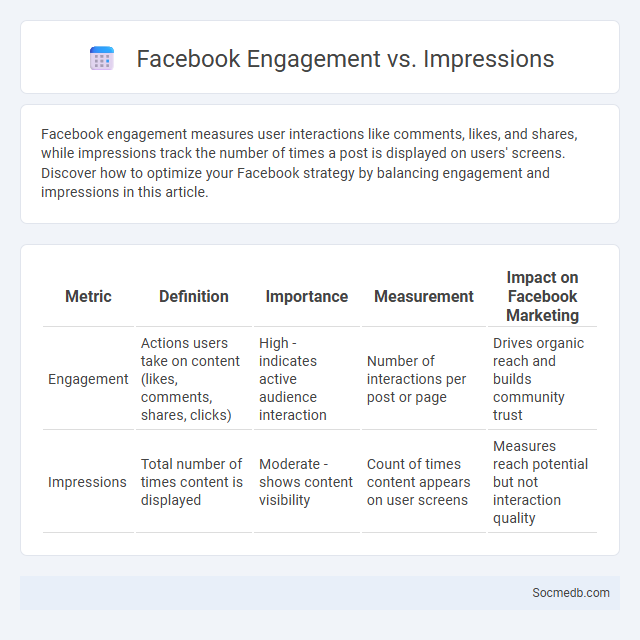
Photo illustration: Facebook Engagement vs Impressions
Facebook engagement measures user interactions like comments, likes, and shares, while impressions track the number of times a post is displayed on users' screens. Discover how to optimize your Facebook strategy by balancing engagement and impressions in this article.
Table of Comparison
| Metric | Definition | Importance | Measurement | Impact on Facebook Marketing |
|---|---|---|---|---|
| Engagement | Actions users take on content (likes, comments, shares, clicks) | High - indicates active audience interaction | Number of interactions per post or page | Drives organic reach and builds community trust |
| Impressions | Total number of times content is displayed | Moderate - shows content visibility | Count of times content appears on user screens | Measures reach potential but not interaction quality |
Understanding Facebook Engagement: Definition and Importance
Facebook engagement refers to the interactions users have with your posts, including likes, comments, shares, and clicks, which directly influence the visibility of your content in news feeds. Higher engagement signals to Facebook's algorithm that your content is valuable, boosting its reach and enabling you to connect with a broader audience. Optimizing your Facebook engagement is essential for building brand awareness, fostering community, and driving meaningful conversations with your target market.
What Are Facebook Impressions?
Facebook impressions represent the total number of times your content is displayed on users' screens, regardless of whether it is clicked or not. This metric helps you understand the reach and visibility of your posts across Facebook feeds, stories, and ads. Monitoring Facebook impressions allows you to gauge the effectiveness of your social media campaigns and optimize your content strategy for maximum engagement.
Key Differences Between Engagement and Impressions
Engagement measures the interactions your audience has with your social media content, including likes, comments, shares, and clicks, reflecting active participation. Impressions represent the total number of times your content is displayed, regardless of whether it was clicked or not, indicating potential visibility. Understanding the key differences between engagement and impressions helps you analyze your content's effectiveness and optimize your social media strategy.
How Facebook Measures Engagement Metrics
Facebook measures engagement metrics primarily through user interactions such as likes, comments, shares, and reactions on posts. The platform also tracks video views, click-through rates, and time spent on content to analyze audience behavior. These metrics enable marketers and content creators to assess content performance and optimize strategies for higher engagement.
The Role of Impressions in Facebook Analytics
Impressions in Facebook Analytics measure the total number of times your content is displayed, providing critical insights into its reach and visibility across the platform. Tracking impressions helps you understand how frequently your audience encounters your posts, influencing strategies to boost engagement and optimize ad performance. By analyzing these metrics, you can refine your content to increase brand awareness and maximize your marketing impact on Facebook.
Engagement Rate vs Impressions Rate: Which Matters More?
Engagement rate measures the level of interaction users have with content, such as likes, comments, shares, and clicks, providing insights into audience connection and content effectiveness. Impressions rate quantifies how often content is displayed, reflecting potential reach and brand visibility but not necessarily indicating user interaction. Prioritizing engagement rate over impressions rate typically yields a better understanding of content performance and audience loyalty, making it crucial for social media marketing strategies aiming to foster active community growth.
Strategies to Boost Facebook Engagement
Boost Facebook engagement by creating high-quality, visually appealing content tailored to your target audience's interests and behaviors. Utilize Facebook Insights to analyze engagement metrics and optimize posting times for maximum reach and interaction. Encourage community interaction by asking questions, hosting live sessions, and responding promptly to comments and messages.
Common Mistakes: Misinterpreting Engagement and Impressions
Misinterpreting engagement and impressions often leads to flawed social media strategies, as impressions only measure how many times content is displayed, not how users interact with it. Many overlook that high impressions without corresponding engagement, such as likes, comments, or shares, indicate limited audience connection or content relevance. You must analyze both metrics contextually to accurately assess your social media performance and adjust your marketing efforts effectively.
Tracking and Analyzing Your Facebook Metrics Effectively
Tracking and analyzing your Facebook metrics effectively involves monitoring key indicators such as engagement rates, reach, and click-through rates to optimize your content strategy. Utilize Facebook Insights and third-party analytics tools to gather detailed data on audience behavior, post performance, and demographic trends. By consistently reviewing these metrics, you can tailor your campaigns to increase visibility, improve user interaction, and achieve better return on investment.
Optimizing Content for Maximum Engagement and Impressions
Optimizing content for maximum engagement and impressions involves analyzing audience behavior and tailoring posts to match peak activity times on major social media platforms like Instagram, Facebook, and Twitter. By incorporating relevant keywords, high-quality visuals, and interactive elements such as polls or questions, you increase the likelihood of your content being shared and commented on. Ensuring your content aligns with trending topics and platform-specific algorithms enhances visibility, helping your brand achieve greater reach and influence.
 socmedb.com
socmedb.com